Diploma of Nursing: Patient Care, Development, and Communication
VerifiedAdded on 2021/04/19
|15
|2752
|41
Homework Assignment
AI Summary
This nursing assignment addresses various aspects of patient care, development, and communication within the context of a Diploma of Nursing program. It begins by outlining the physical, cognitive, and psychosocial development of children from infancy through adolescence. The assignment then explores effective communication strategies, emphasizing empathy, attentiveness, and clear documentation. It details the discharge process, including report summaries and referrals. Furthermore, it covers patient assessment, including history taking, general appearance evaluation, and vital sign monitoring for infants, toddlers, and adolescents. The assessment includes observations of respiratory rate, temperature, heart rate, pain levels, and oxygen saturation. Focused assessments cover breathing, airway, circulation, disability, skin, nutrition/hydration, and psychological well-being. The assignment also discusses the impact of prolonged hospitalization on child development, the effects of infertility, the benefits of interaction with children, and factors influencing health outcomes. It concludes with sections on maintaining respect and dignity, gender-related health differences, and assessing patient deterioration and consciousness.
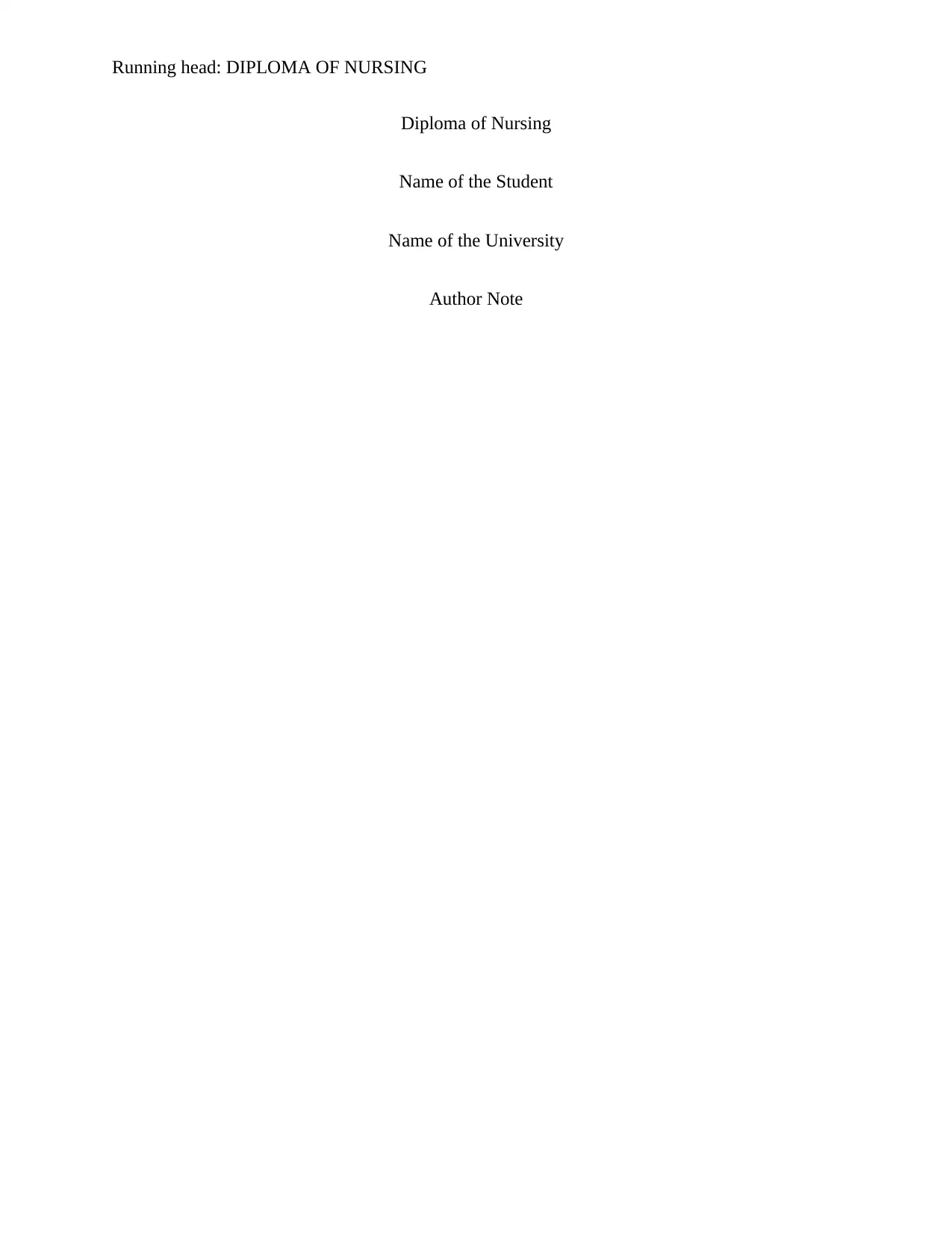
Running head: DIPLOMA OF NURSING
Diploma of Nursing
Name of the Student
Name of the University
Author Note
Diploma of Nursing
Name of the Student
Name of the University
Author Note
Paraphrase This Document
Need a fresh take? Get an instant paraphrase of this document with our AI Paraphraser
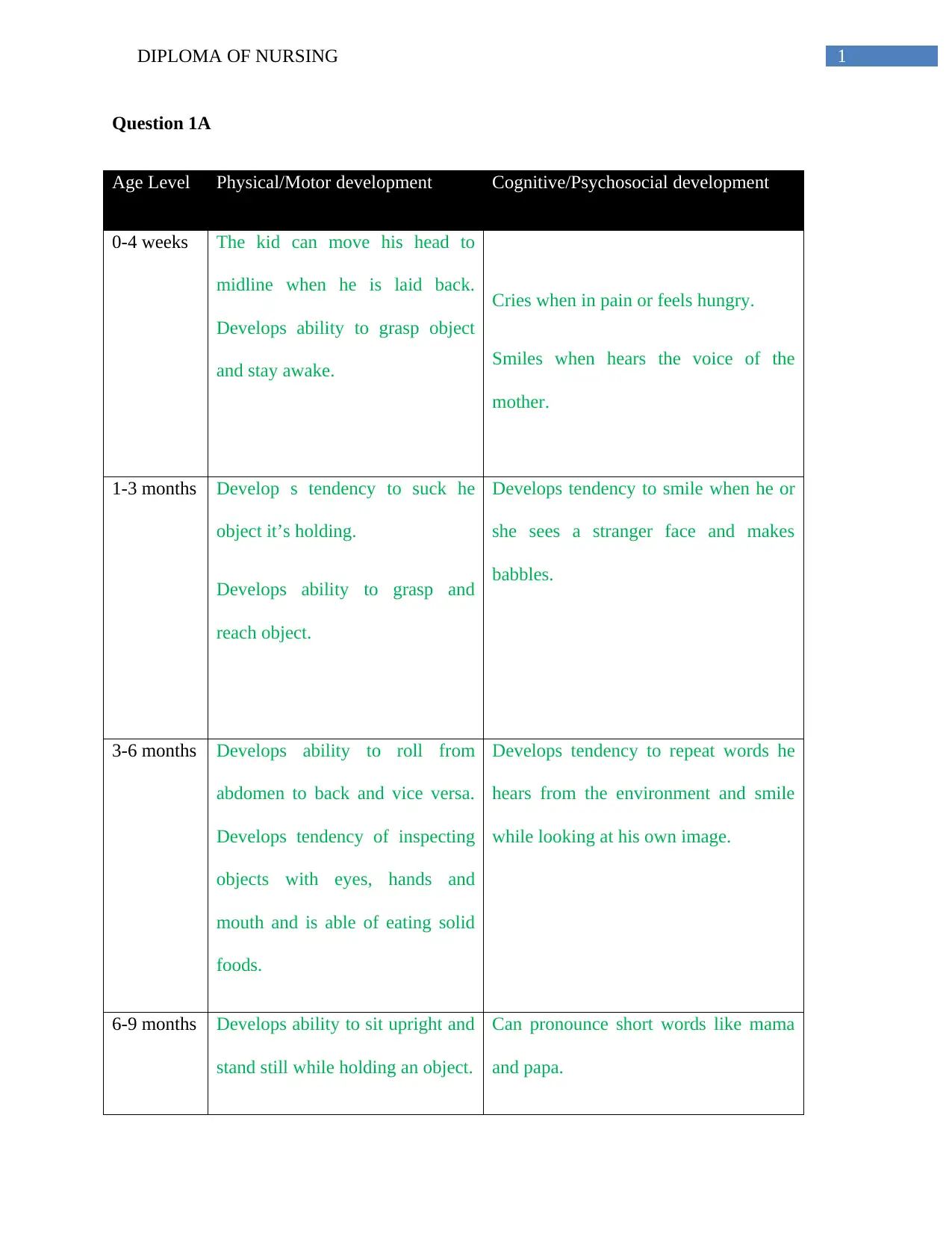
1DIPLOMA OF NURSING
Question 1A
Age Level Physical/Motor development deve Cognitive/Psychosocial development
0-4 weeks The kid can move his head to
midline when he is laid back.
Develops ability to grasp object
and stay awake.
Cries when in pain or feels hungry.
Smiles when hears the voice of the
mother.
1-3 months Develop s tendency to suck he
object it’s holding.
Develops ability to grasp and
reach object.
Develops tendency to smile when he or
she sees a stranger face and makes
babbles.
3-6 months Develops ability to roll from
abdomen to back and vice versa.
Develops tendency of inspecting
objects with eyes, hands and
mouth and is able of eating solid
foods.
Develops tendency to repeat words he
hears from the environment and smile
while looking at his own image.
6-9 months Develops ability to sit upright and
stand still while holding an object.
Can pronounce short words like mama
and papa.
Question 1A
Age Level Physical/Motor development deve Cognitive/Psychosocial development
0-4 weeks The kid can move his head to
midline when he is laid back.
Develops ability to grasp object
and stay awake.
Cries when in pain or feels hungry.
Smiles when hears the voice of the
mother.
1-3 months Develop s tendency to suck he
object it’s holding.
Develops ability to grasp and
reach object.
Develops tendency to smile when he or
she sees a stranger face and makes
babbles.
3-6 months Develops ability to roll from
abdomen to back and vice versa.
Develops tendency of inspecting
objects with eyes, hands and
mouth and is able of eating solid
foods.
Develops tendency to repeat words he
hears from the environment and smile
while looking at his own image.
6-9 months Develops ability to sit upright and
stand still while holding an object.
Can pronounce short words like mama
and papa.
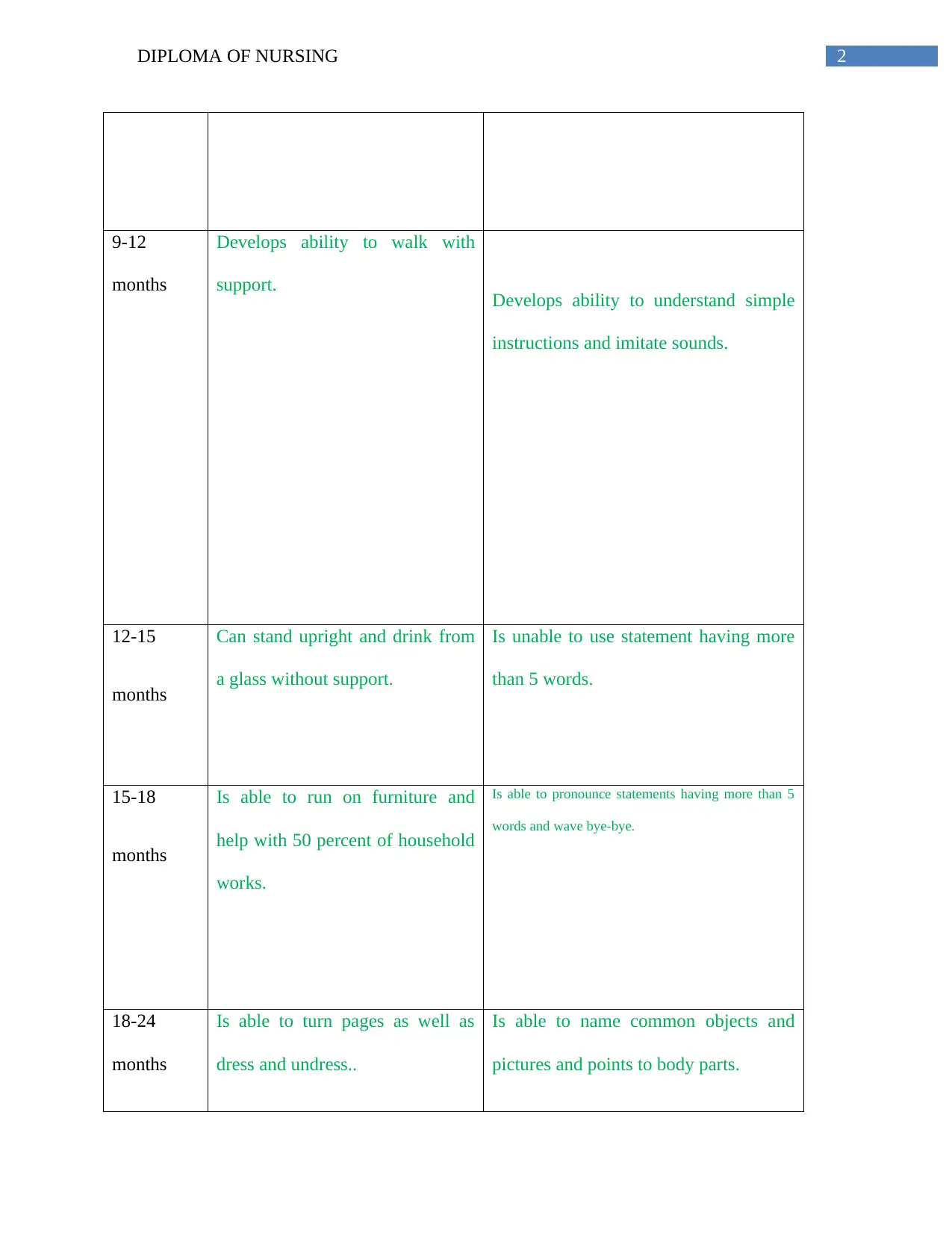
2DIPLOMA OF NURSING
9-12
months
Develops ability to walk with
support. Develops ability to understand simple
instructions and imitate sounds.
12-15
months
Can stand upright and drink from
a glass without support.
Is unable to use statement having more
than 5 words.
15-18
months
Is able to run on furniture and
help with 50 percent of household
works.
Is able to pronounce statements having more than 5
words and wave bye-bye.
18-24
months
Is able to turn pages as well as
dress and undress..
Is able to name common objects and
pictures and points to body parts.
9-12
months
Develops ability to walk with
support. Develops ability to understand simple
instructions and imitate sounds.
12-15
months
Can stand upright and drink from
a glass without support.
Is unable to use statement having more
than 5 words.
15-18
months
Is able to run on furniture and
help with 50 percent of household
works.
Is able to pronounce statements having more than 5
words and wave bye-bye.
18-24
months
Is able to turn pages as well as
dress and undress..
Is able to name common objects and
pictures and points to body parts.
⊘ This is a preview!⊘
Do you want full access?
Subscribe today to unlock all pages.

Trusted by 1+ million students worldwide
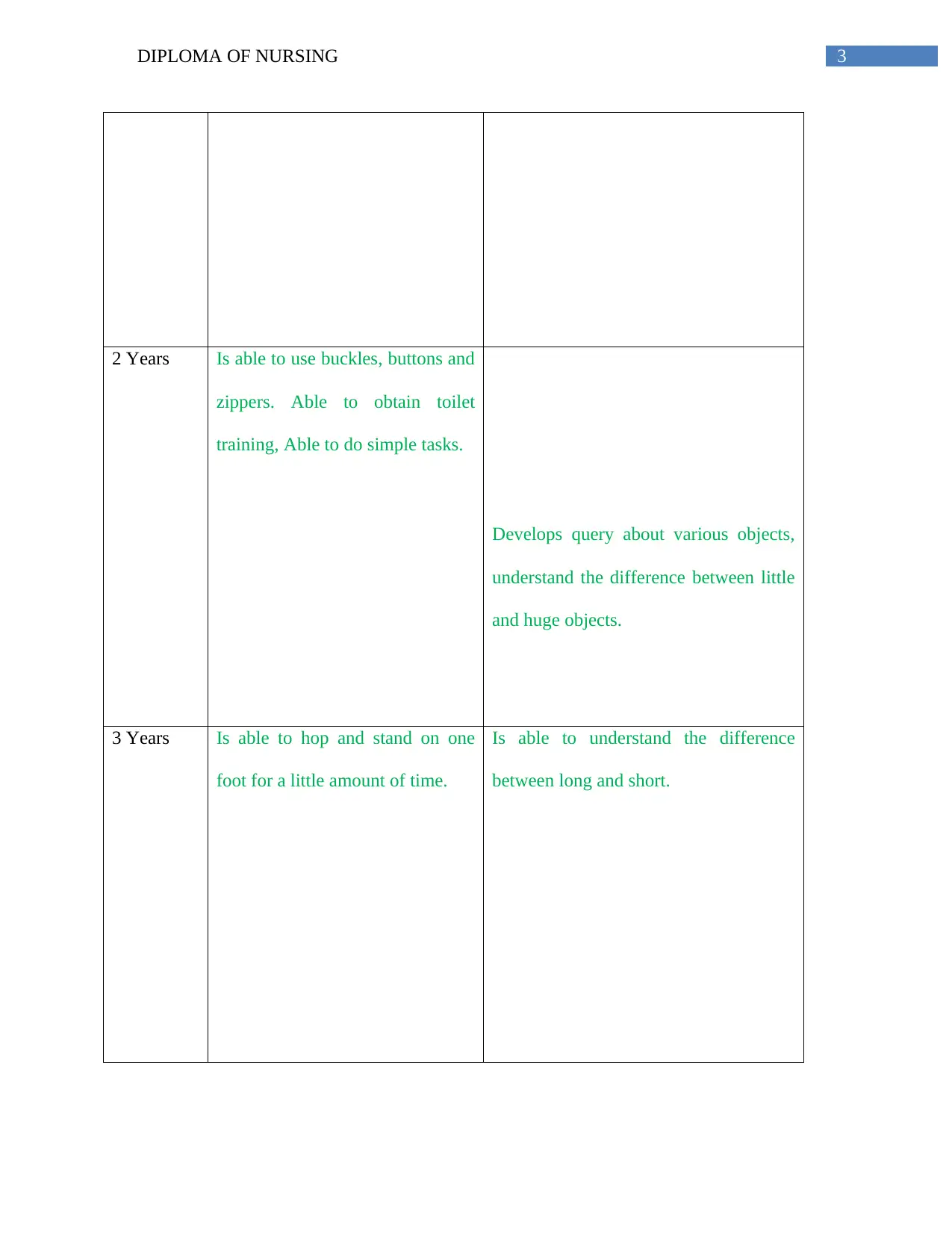
3DIPLOMA OF NURSING
2 Years Is able to use buckles, buttons and
zippers. Able to obtain toilet
training, Able to do simple tasks.
Develops query about various objects,
understand the difference between little
and huge objects.
3 Years Is able to hop and stand on one
foot for a little amount of time.
Is able to understand the difference
between long and short.
2 Years Is able to use buckles, buttons and
zippers. Able to obtain toilet
training, Able to do simple tasks.
Develops query about various objects,
understand the difference between little
and huge objects.
3 Years Is able to hop and stand on one
foot for a little amount of time.
Is able to understand the difference
between long and short.
Paraphrase This Document
Need a fresh take? Get an instant paraphrase of this document with our AI Paraphraser
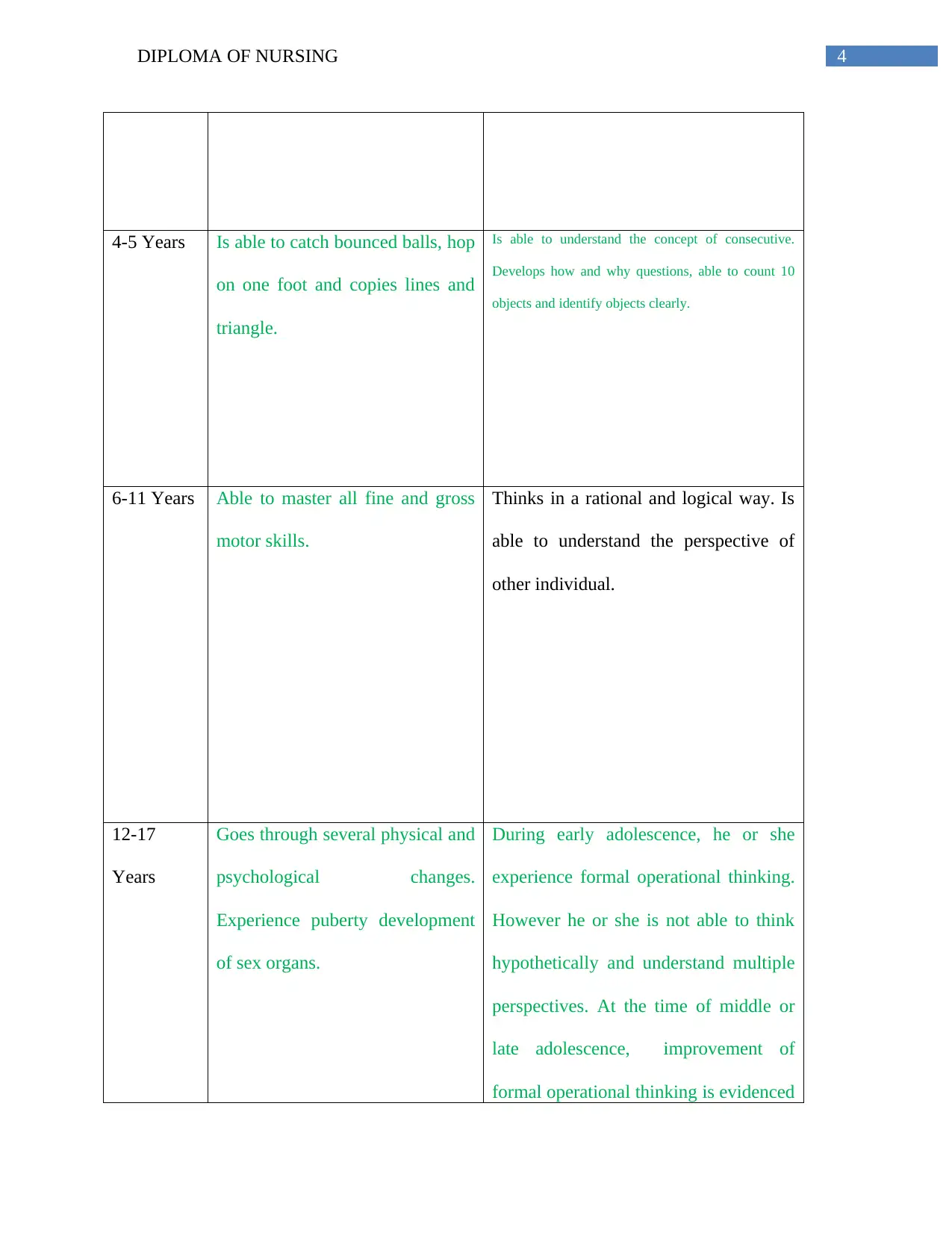
4DIPLOMA OF NURSING
4-5 Years Is able to catch bounced balls, hop
on one foot and copies lines and
triangle.
Is able to understand the concept of consecutive.
Develops how and why questions, able to count 10
objects and identify objects clearly.
6-11 Years Able to master all fine and gross
motor skills.
Thinks in a rational and logical way. Is
able to understand the perspective of
other individual.
12-17
Years
Goes through several physical and
psychological changes.
Experience puberty development
of sex organs.
During early adolescence, he or she
experience formal operational thinking.
However he or she is not able to think
hypothetically and understand multiple
perspectives. At the time of middle or
late adolescence, improvement of
formal operational thinking is evidenced
4-5 Years Is able to catch bounced balls, hop
on one foot and copies lines and
triangle.
Is able to understand the concept of consecutive.
Develops how and why questions, able to count 10
objects and identify objects clearly.
6-11 Years Able to master all fine and gross
motor skills.
Thinks in a rational and logical way. Is
able to understand the perspective of
other individual.
12-17
Years
Goes through several physical and
psychological changes.
Experience puberty development
of sex organs.
During early adolescence, he or she
experience formal operational thinking.
However he or she is not able to think
hypothetically and understand multiple
perspectives. At the time of middle or
late adolescence, improvement of
formal operational thinking is evidenced
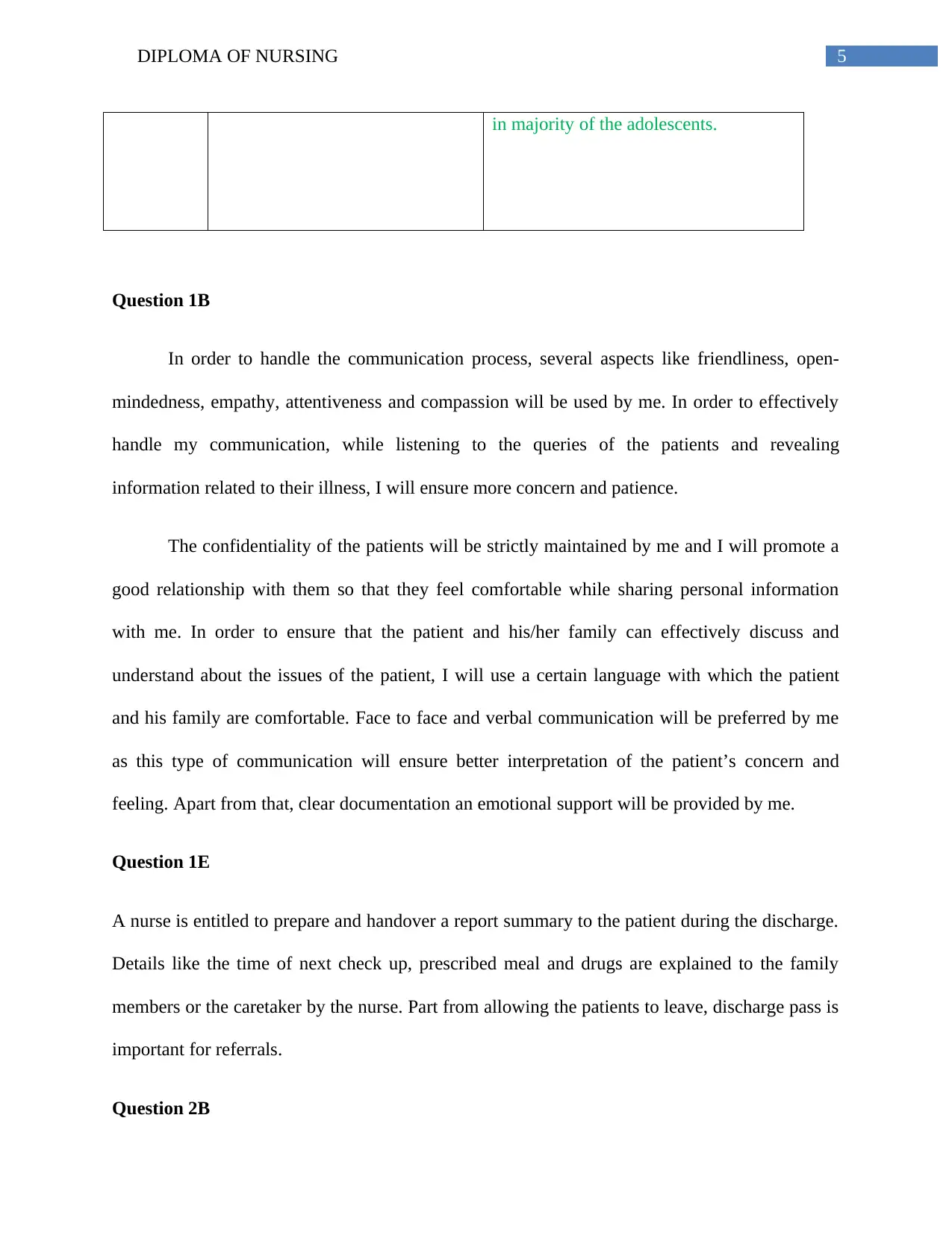
5DIPLOMA OF NURSING
in majority of the adolescents.
Question 1B
In order to handle the communication process, several aspects like friendliness, open-
mindedness, empathy, attentiveness and compassion will be used by me. In order to effectively
handle my communication, while listening to the queries of the patients and revealing
information related to their illness, I will ensure more concern and patience.
The confidentiality of the patients will be strictly maintained by me and I will promote a
good relationship with them so that they feel comfortable while sharing personal information
with me. In order to ensure that the patient and his/her family can effectively discuss and
understand about the issues of the patient, I will use a certain language with which the patient
and his family are comfortable. Face to face and verbal communication will be preferred by me
as this type of communication will ensure better interpretation of the patient’s concern and
feeling. Apart from that, clear documentation an emotional support will be provided by me.
Question 1E
A nurse is entitled to prepare and handover a report summary to the patient during the discharge.
Details like the time of next check up, prescribed meal and drugs are explained to the family
members or the caretaker by the nurse. Part from allowing the patients to leave, discharge pass is
important for referrals.
Question 2B
in majority of the adolescents.
Question 1B
In order to handle the communication process, several aspects like friendliness, open-
mindedness, empathy, attentiveness and compassion will be used by me. In order to effectively
handle my communication, while listening to the queries of the patients and revealing
information related to their illness, I will ensure more concern and patience.
The confidentiality of the patients will be strictly maintained by me and I will promote a
good relationship with them so that they feel comfortable while sharing personal information
with me. In order to ensure that the patient and his/her family can effectively discuss and
understand about the issues of the patient, I will use a certain language with which the patient
and his family are comfortable. Face to face and verbal communication will be preferred by me
as this type of communication will ensure better interpretation of the patient’s concern and
feeling. Apart from that, clear documentation an emotional support will be provided by me.
Question 1E
A nurse is entitled to prepare and handover a report summary to the patient during the discharge.
Details like the time of next check up, prescribed meal and drugs are explained to the family
members or the caretaker by the nurse. Part from allowing the patients to leave, discharge pass is
important for referrals.
Question 2B
⊘ This is a preview!⊘
Do you want full access?
Subscribe today to unlock all pages.

Trusted by 1+ million students worldwide
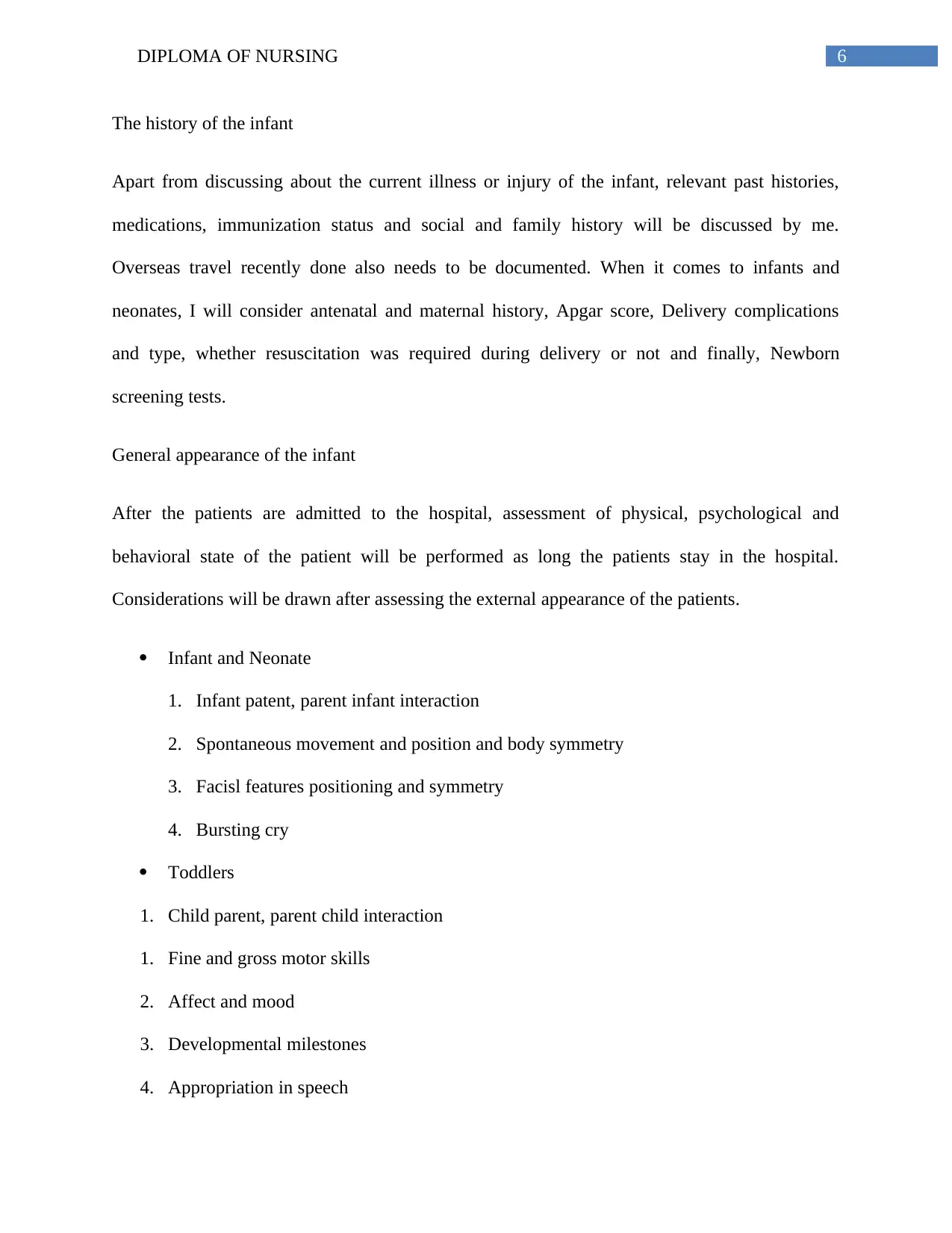
6DIPLOMA OF NURSING
The history of the infant
Apart from discussing about the current illness or injury of the infant, relevant past histories,
medications, immunization status and social and family history will be discussed by me.
Overseas travel recently done also needs to be documented. When it comes to infants and
neonates, I will consider antenatal and maternal history, Apgar score, Delivery complications
and type, whether resuscitation was required during delivery or not and finally, Newborn
screening tests.
General appearance of the infant
After the patients are admitted to the hospital, assessment of physical, psychological and
behavioral state of the patient will be performed as long the patients stay in the hospital.
Considerations will be drawn after assessing the external appearance of the patients.
Infant and Neonate
1. Infant patent, parent infant interaction
2. Spontaneous movement and position and body symmetry
3. Facisl features positioning and symmetry
4. Bursting cry
Toddlers
1. Child parent, parent child interaction
1. Fine and gross motor skills
2. Affect and mood
3. Developmental milestones
4. Appropriation in speech
The history of the infant
Apart from discussing about the current illness or injury of the infant, relevant past histories,
medications, immunization status and social and family history will be discussed by me.
Overseas travel recently done also needs to be documented. When it comes to infants and
neonates, I will consider antenatal and maternal history, Apgar score, Delivery complications
and type, whether resuscitation was required during delivery or not and finally, Newborn
screening tests.
General appearance of the infant
After the patients are admitted to the hospital, assessment of physical, psychological and
behavioral state of the patient will be performed as long the patients stay in the hospital.
Considerations will be drawn after assessing the external appearance of the patients.
Infant and Neonate
1. Infant patent, parent infant interaction
2. Spontaneous movement and position and body symmetry
3. Facisl features positioning and symmetry
4. Bursting cry
Toddlers
1. Child parent, parent child interaction
1. Fine and gross motor skills
2. Affect and mood
3. Developmental milestones
4. Appropriation in speech
Paraphrase This Document
Need a fresh take? Get an instant paraphrase of this document with our AI Paraphraser
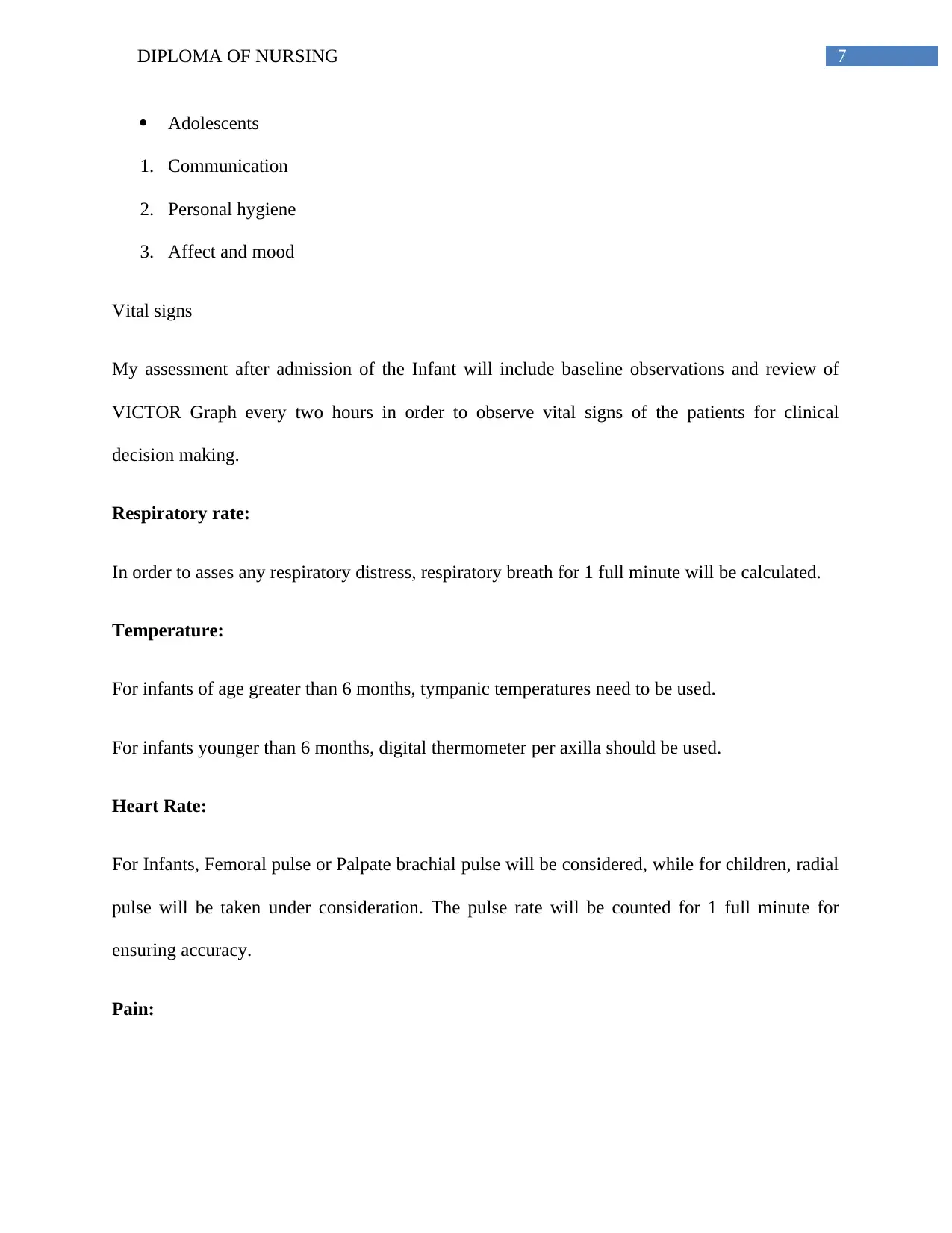
7DIPLOMA OF NURSING
Adolescents
1. Communication
2. Personal hygiene
3. Affect and mood
Vital signs
My assessment after admission of the Infant will include baseline observations and review of
VICTOR Graph every two hours in order to observe vital signs of the patients for clinical
decision making.
Respiratory rate:
In order to asses any respiratory distress, respiratory breath for 1 full minute will be calculated.
Temperature:
For infants of age greater than 6 months, tympanic temperatures need to be used.
For infants younger than 6 months, digital thermometer per axilla should be used.
Heart Rate:
For Infants, Femoral pulse or Palpate brachial pulse will be considered, while for children, radial
pulse will be taken under consideration. The pulse rate will be counted for 1 full minute for
ensuring accuracy.
Pain:
Adolescents
1. Communication
2. Personal hygiene
3. Affect and mood
Vital signs
My assessment after admission of the Infant will include baseline observations and review of
VICTOR Graph every two hours in order to observe vital signs of the patients for clinical
decision making.
Respiratory rate:
In order to asses any respiratory distress, respiratory breath for 1 full minute will be calculated.
Temperature:
For infants of age greater than 6 months, tympanic temperatures need to be used.
For infants younger than 6 months, digital thermometer per axilla should be used.
Heart Rate:
For Infants, Femoral pulse or Palpate brachial pulse will be considered, while for children, radial
pulse will be taken under consideration. The pulse rate will be counted for 1 full minute for
ensuring accuracy.
Pain:
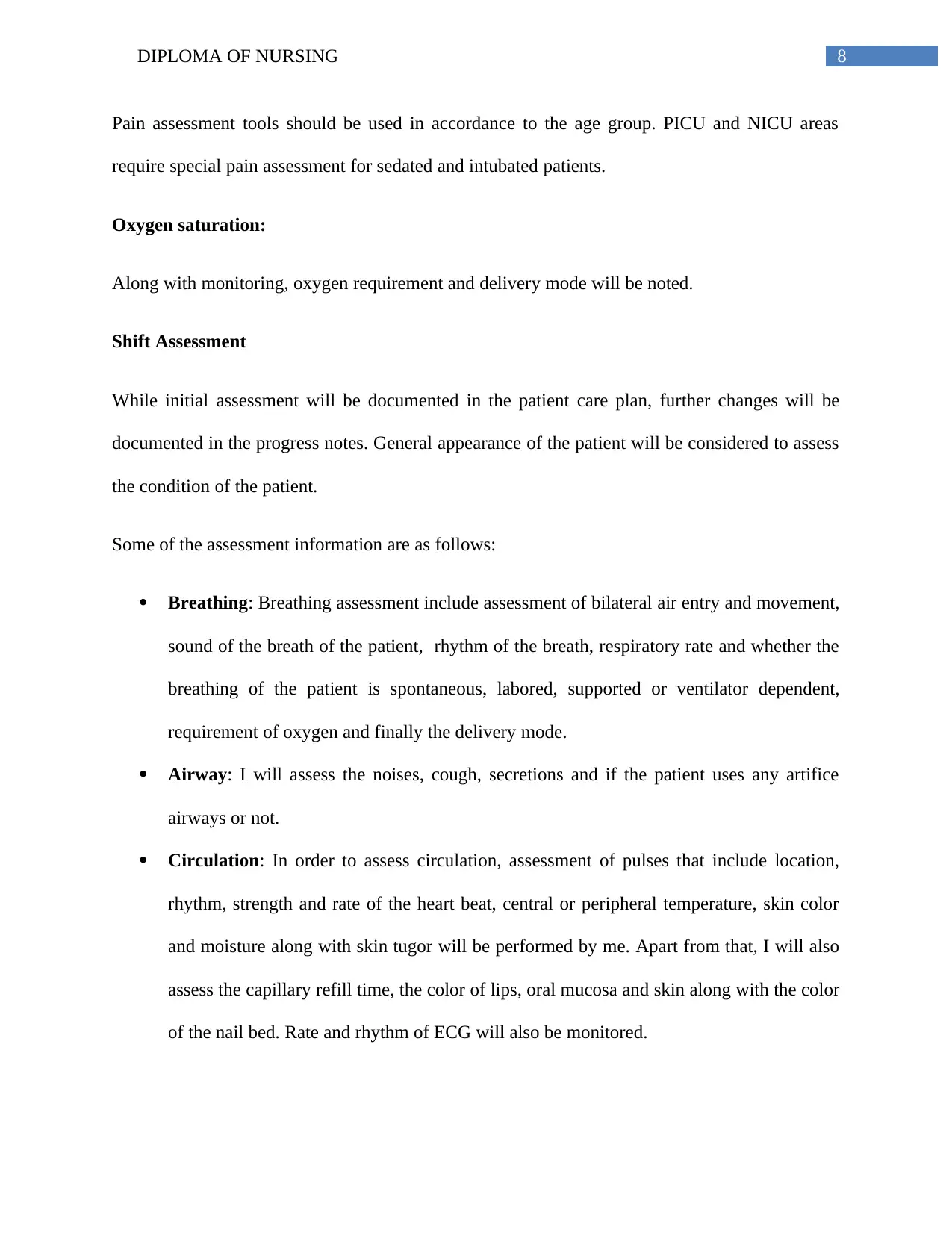
8DIPLOMA OF NURSING
Pain assessment tools should be used in accordance to the age group. PICU and NICU areas
require special pain assessment for sedated and intubated patients.
Oxygen saturation:
Along with monitoring, oxygen requirement and delivery mode will be noted.
Shift Assessment
While initial assessment will be documented in the patient care plan, further changes will be
documented in the progress notes. General appearance of the patient will be considered to assess
the condition of the patient.
Some of the assessment information are as follows:
Breathing: Breathing assessment include assessment of bilateral air entry and movement,
sound of the breath of the patient, rhythm of the breath, respiratory rate and whether the
breathing of the patient is spontaneous, labored, supported or ventilator dependent,
requirement of oxygen and finally the delivery mode.
Airway: I will assess the noises, cough, secretions and if the patient uses any artifice
airways or not.
Circulation: In order to assess circulation, assessment of pulses that include location,
rhythm, strength and rate of the heart beat, central or peripheral temperature, skin color
and moisture along with skin tugor will be performed by me. Apart from that, I will also
assess the capillary refill time, the color of lips, oral mucosa and skin along with the color
of the nail bed. Rate and rhythm of ECG will also be monitored.
Pain assessment tools should be used in accordance to the age group. PICU and NICU areas
require special pain assessment for sedated and intubated patients.
Oxygen saturation:
Along with monitoring, oxygen requirement and delivery mode will be noted.
Shift Assessment
While initial assessment will be documented in the patient care plan, further changes will be
documented in the progress notes. General appearance of the patient will be considered to assess
the condition of the patient.
Some of the assessment information are as follows:
Breathing: Breathing assessment include assessment of bilateral air entry and movement,
sound of the breath of the patient, rhythm of the breath, respiratory rate and whether the
breathing of the patient is spontaneous, labored, supported or ventilator dependent,
requirement of oxygen and finally the delivery mode.
Airway: I will assess the noises, cough, secretions and if the patient uses any artifice
airways or not.
Circulation: In order to assess circulation, assessment of pulses that include location,
rhythm, strength and rate of the heart beat, central or peripheral temperature, skin color
and moisture along with skin tugor will be performed by me. Apart from that, I will also
assess the capillary refill time, the color of lips, oral mucosa and skin along with the color
of the nail bed. Rate and rhythm of ECG will also be monitored.
⊘ This is a preview!⊘
Do you want full access?
Subscribe today to unlock all pages.

Trusted by 1+ million students worldwide
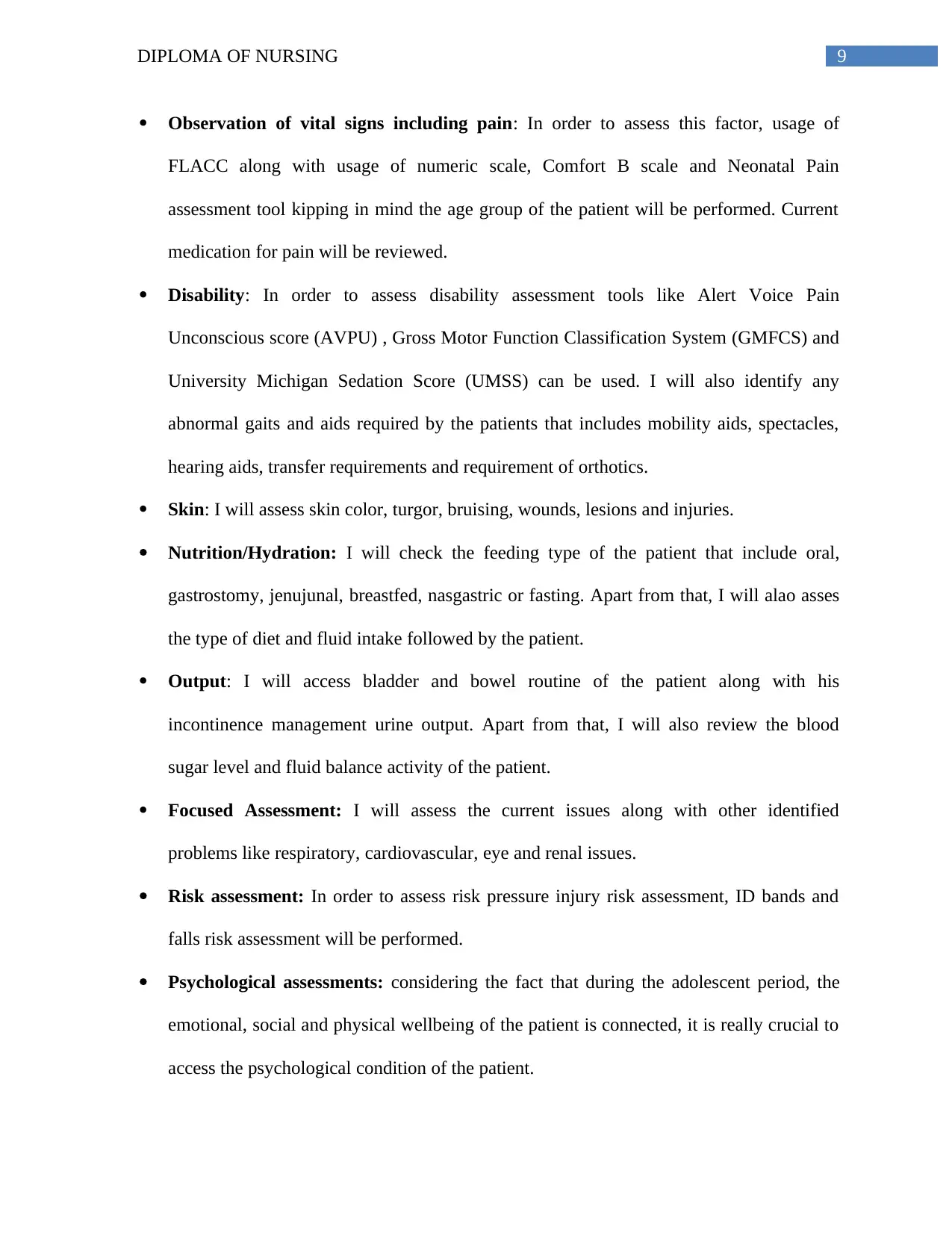
9DIPLOMA OF NURSING
Observation of vital signs including pain: In order to assess this factor, usage of
FLACC along with usage of numeric scale, Comfort B scale and Neonatal Pain
assessment tool kipping in mind the age group of the patient will be performed. Current
medication for pain will be reviewed.
Disability: In order to assess disability assessment tools like Alert Voice Pain
Unconscious score (AVPU) , Gross Motor Function Classification System (GMFCS) and
University Michigan Sedation Score (UMSS) can be used. I will also identify any
abnormal gaits and aids required by the patients that includes mobility aids, spectacles,
hearing aids, transfer requirements and requirement of orthotics.
Skin: I will assess skin color, turgor, bruising, wounds, lesions and injuries.
Nutrition/Hydration: I will check the feeding type of the patient that include oral,
gastrostomy, jenujunal, breastfed, nasgastric or fasting. Apart from that, I will alao asses
the type of diet and fluid intake followed by the patient.
Output: I will access bladder and bowel routine of the patient along with his
incontinence management urine output. Apart from that, I will also review the blood
sugar level and fluid balance activity of the patient.
Focused Assessment: I will assess the current issues along with other identified
problems like respiratory, cardiovascular, eye and renal issues.
Risk assessment: In order to assess risk pressure injury risk assessment, ID bands and
falls risk assessment will be performed.
Psychological assessments: considering the fact that during the adolescent period, the
emotional, social and physical wellbeing of the patient is connected, it is really crucial to
access the psychological condition of the patient.
Observation of vital signs including pain: In order to assess this factor, usage of
FLACC along with usage of numeric scale, Comfort B scale and Neonatal Pain
assessment tool kipping in mind the age group of the patient will be performed. Current
medication for pain will be reviewed.
Disability: In order to assess disability assessment tools like Alert Voice Pain
Unconscious score (AVPU) , Gross Motor Function Classification System (GMFCS) and
University Michigan Sedation Score (UMSS) can be used. I will also identify any
abnormal gaits and aids required by the patients that includes mobility aids, spectacles,
hearing aids, transfer requirements and requirement of orthotics.
Skin: I will assess skin color, turgor, bruising, wounds, lesions and injuries.
Nutrition/Hydration: I will check the feeding type of the patient that include oral,
gastrostomy, jenujunal, breastfed, nasgastric or fasting. Apart from that, I will alao asses
the type of diet and fluid intake followed by the patient.
Output: I will access bladder and bowel routine of the patient along with his
incontinence management urine output. Apart from that, I will also review the blood
sugar level and fluid balance activity of the patient.
Focused Assessment: I will assess the current issues along with other identified
problems like respiratory, cardiovascular, eye and renal issues.
Risk assessment: In order to assess risk pressure injury risk assessment, ID bands and
falls risk assessment will be performed.
Psychological assessments: considering the fact that during the adolescent period, the
emotional, social and physical wellbeing of the patient is connected, it is really crucial to
access the psychological condition of the patient.
Paraphrase This Document
Need a fresh take? Get an instant paraphrase of this document with our AI Paraphraser
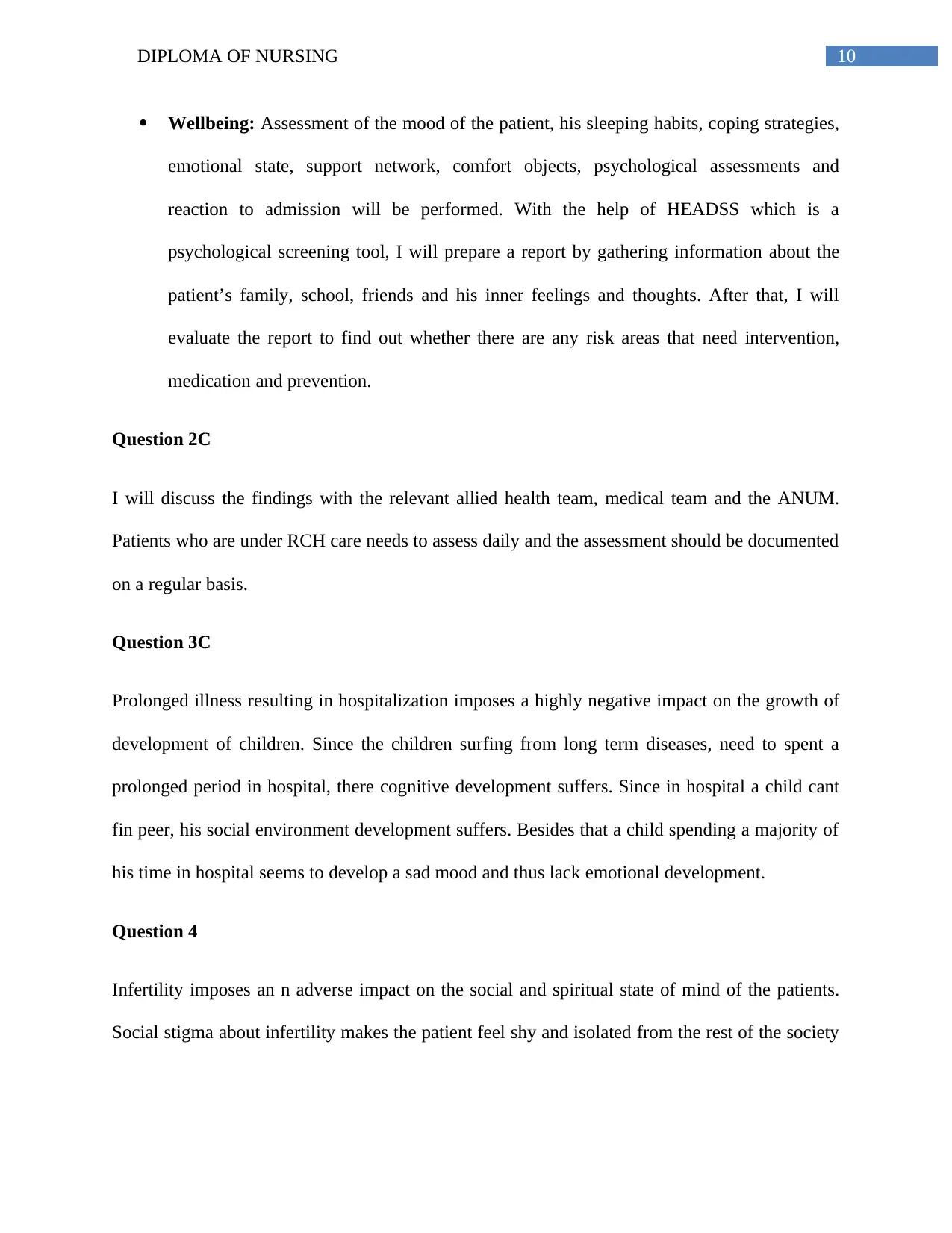
10DIPLOMA OF NURSING
Wellbeing: Assessment of the mood of the patient, his sleeping habits, coping strategies,
emotional state, support network, comfort objects, psychological assessments and
reaction to admission will be performed. With the help of HEADSS which is a
psychological screening tool, I will prepare a report by gathering information about the
patient’s family, school, friends and his inner feelings and thoughts. After that, I will
evaluate the report to find out whether there are any risk areas that need intervention,
medication and prevention.
Question 2C
I will discuss the findings with the relevant allied health team, medical team and the ANUM.
Patients who are under RCH care needs to assess daily and the assessment should be documented
on a regular basis.
Question 3C
Prolonged illness resulting in hospitalization imposes a highly negative impact on the growth of
development of children. Since the children surfing from long term diseases, need to spent a
prolonged period in hospital, there cognitive development suffers. Since in hospital a child cant
fin peer, his social environment development suffers. Besides that a child spending a majority of
his time in hospital seems to develop a sad mood and thus lack emotional development.
Question 4
Infertility imposes an n adverse impact on the social and spiritual state of mind of the patients.
Social stigma about infertility makes the patient feel shy and isolated from the rest of the society
Wellbeing: Assessment of the mood of the patient, his sleeping habits, coping strategies,
emotional state, support network, comfort objects, psychological assessments and
reaction to admission will be performed. With the help of HEADSS which is a
psychological screening tool, I will prepare a report by gathering information about the
patient’s family, school, friends and his inner feelings and thoughts. After that, I will
evaluate the report to find out whether there are any risk areas that need intervention,
medication and prevention.
Question 2C
I will discuss the findings with the relevant allied health team, medical team and the ANUM.
Patients who are under RCH care needs to assess daily and the assessment should be documented
on a regular basis.
Question 3C
Prolonged illness resulting in hospitalization imposes a highly negative impact on the growth of
development of children. Since the children surfing from long term diseases, need to spent a
prolonged period in hospital, there cognitive development suffers. Since in hospital a child cant
fin peer, his social environment development suffers. Besides that a child spending a majority of
his time in hospital seems to develop a sad mood and thus lack emotional development.
Question 4
Infertility imposes an n adverse impact on the social and spiritual state of mind of the patients.
Social stigma about infertility makes the patient feel shy and isolated from the rest of the society
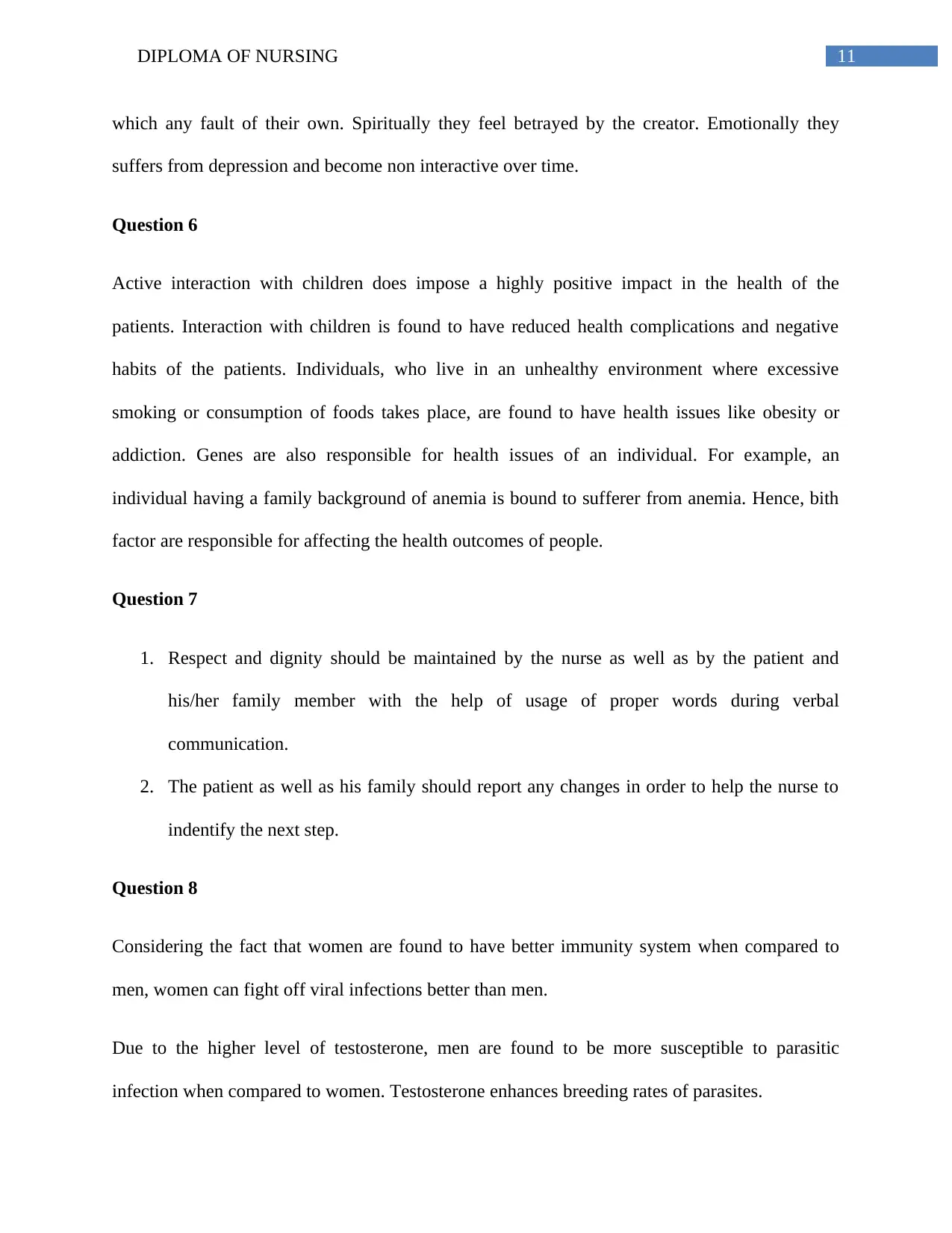
11DIPLOMA OF NURSING
which any fault of their own. Spiritually they feel betrayed by the creator. Emotionally they
suffers from depression and become non interactive over time.
Question 6
Active interaction with children does impose a highly positive impact in the health of the
patients. Interaction with children is found to have reduced health complications and negative
habits of the patients. Individuals, who live in an unhealthy environment where excessive
smoking or consumption of foods takes place, are found to have health issues like obesity or
addiction. Genes are also responsible for health issues of an individual. For example, an
individual having a family background of anemia is bound to sufferer from anemia. Hence, bith
factor are responsible for affecting the health outcomes of people.
Question 7
1. Respect and dignity should be maintained by the nurse as well as by the patient and
his/her family member with the help of usage of proper words during verbal
communication.
2. The patient as well as his family should report any changes in order to help the nurse to
indentify the next step.
Question 8
Considering the fact that women are found to have better immunity system when compared to
men, women can fight off viral infections better than men.
Due to the higher level of testosterone, men are found to be more susceptible to parasitic
infection when compared to women. Testosterone enhances breeding rates of parasites.
which any fault of their own. Spiritually they feel betrayed by the creator. Emotionally they
suffers from depression and become non interactive over time.
Question 6
Active interaction with children does impose a highly positive impact in the health of the
patients. Interaction with children is found to have reduced health complications and negative
habits of the patients. Individuals, who live in an unhealthy environment where excessive
smoking or consumption of foods takes place, are found to have health issues like obesity or
addiction. Genes are also responsible for health issues of an individual. For example, an
individual having a family background of anemia is bound to sufferer from anemia. Hence, bith
factor are responsible for affecting the health outcomes of people.
Question 7
1. Respect and dignity should be maintained by the nurse as well as by the patient and
his/her family member with the help of usage of proper words during verbal
communication.
2. The patient as well as his family should report any changes in order to help the nurse to
indentify the next step.
Question 8
Considering the fact that women are found to have better immunity system when compared to
men, women can fight off viral infections better than men.
Due to the higher level of testosterone, men are found to be more susceptible to parasitic
infection when compared to women. Testosterone enhances breeding rates of parasites.
⊘ This is a preview!⊘
Do you want full access?
Subscribe today to unlock all pages.

Trusted by 1+ million students worldwide
1 out of 15
Your All-in-One AI-Powered Toolkit for Academic Success.
+13062052269
info@desklib.com
Available 24*7 on WhatsApp / Email
![[object Object]](/_next/static/media/star-bottom.7253800d.svg)
Unlock your academic potential
Copyright © 2020–2025 A2Z Services. All Rights Reserved. Developed and managed by ZUCOL.


